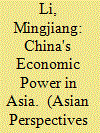|
|
|
Sort Order |
|
|
|
Items / Page
|
|
|
|
|
|
|
| Srl | Item |
| 1 |
ID:
165730


|
|
|
|
|
| Summary/Abstract |
China's growing economic power has been identified as a major factor in generating profound transformations in the strategic landscape in Asia. Beijing's interest in using its economic power for the pursuit of geopolitical objectives remains strong. Many analysts believe that the ambitious Belt and Road Initiative (BRI) represents the continuation and even intensification of that interest. I unpack the role of China's economic power in its external relations by focusing on how Guangxi, a subnational government in China, has facilitated the emergence of the BRI. My study suggests that in-depth knowledge about local governments' activism in socioeconomic engagements with neighboring countries contributes significantly to a more nuanced understanding of China's power, particularly its economic power in Asia.
|
|
|
|
|
|
|
|
|
|
|
|
|
|
|
|
| 2 |
ID:
113897


|
|
|
|
|
| Publication |
2011.
|
| Summary/Abstract |
Studies of internal migration in contemporary China frequently focus on the movement of rural people to urban centers, while studies of Chinese tourism concentrate on the mobility of urban travelers. These approaches to mobility coincide neatly with established understandings of modernity, despite the fact that the Chinese government has tried to promote certain forms of rural modernization without mobilization-hence the national slogan "leave the fields without leaving the countryside." This article complicates the relationship between modernity and mobility in China by examining mobility from the perspective of returned migrants in rural, ethnic minority tourism villages. Through the analysis of five migrants' stories of travel, I explore the ordering of mobility, or how differing types of mobility come to be re-signified in times of immense social change and the consequences of these symbolic shifts on local understandings of ethnic identity and rural livelihoods. My argument builds on analytical frameworks of mobility in post-reform China by examining how mobility itself has been ordered in ways that reveal particular desire, inequalities, and power relations. By exploring how mobility both orders social relationships and how different forms of mobility, such as tourism or migration, come to be ordered in relation to each other, I draw attention to how mobility, and by extension immobility, generates the conditions of possibility for tourism village residents to make sense of the potential and paradoxes of rural, ethnic tourism development in contemporary China.
|
|
|
|
|
|
|
|
|
|
|
|
|
|
|
|
| 3 |
ID:
151477


|
|
|
|
|
| Summary/Abstract |
This article is devoted to establishing, by means of textual and comparative evidence, a link between the religious practitioners called mogong (Zh. bouxmo) and chiefly houses. The mogong are male priests who recite texts in the ‘local’ language, in this case Zhuang or Bouyei. They are also found among other Tai peoples, including the Dai in Yunnan, the Tày and Nùng in Vietnam, and also among other ethnic groups in mainland Southeast Asia. Theirs is a very ancient tradition, dating back possibly 2000 years. Most of the studies on mogong in the PRC have treated the mogong either as an instance of ‘primitive religion’ or as ‘folk beliefs’, and some scholars have declared that the mogong had no connection with politics or government. My argument, based on new evidence from a survey of Zhuang vernacular texts, is that the Zhuang mogong only became village-level vernacular priests after the disbandment of the native chieftaincies, starting in the early eighteenth century, and that before that they were attached directly to chiefly lineages, as they still were in Yunnan and in Southeast Asia until the 1940s. The mogong were responsible for the most important triennial sacrifices to the guardian spirits of the domain.
|
|
|
|
|
|
|
|
|
|
|
|
|
|
|
|
| 4 |
ID:
183462


|
|
|
|
|
| Summary/Abstract |
Following their victory in the Chinese Civil War, the Chinese Communists initiated a nationwide counterinsurgency. In Guangxi, a mountainous province at the China-Vietnam border, anti-communist rebels waged an insurgency from 1949 to 1952, hoping that foreign support and Cold War rivalries could eventually restore the ancien régime. This research investigates the counterinsurgency in Guangxi, one of the more mutinous provinces in post-Civil War China. By situating the Guangxi counterinsurgency in the global context, this article aims to contribute to the discussion of Chinese counterinsurgency strategy, experience and how the People’s Republic’s triumphed over the armed resistance.
|
|
|
|
|
|
|
|
|
|
|
|
|
|
|
|
|
|
|
|
|